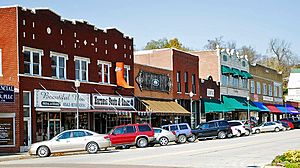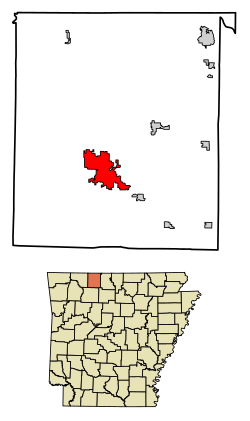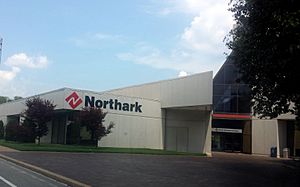Harrison, Arkansas facts for kids
Quick facts for kids
Harrison
|
|
|---|---|
|
City
|
|

Historic downtown Harrison
|
|
| Motto(s):
"Adventure Awaits You"
|
|

Location of Harrison in Boone County, Arkansas.
|
|
| Country | United States |
| State | Arkansas |
| County | Boone |
| Platted | 1869 |
| Incorporated | March 1, 1876 |
| Area | |
| • Total | 11.23 sq mi (29.09 km2) |
| • Land | 11.21 sq mi (29.02 km2) |
| • Water | 0.03 sq mi (0.07 km2) |
| Elevation | 1,050 ft (320 m) |
| Population
(2020)
|
|
| • Total | 13,069 |
| • Density | 1,166.35/sq mi (450.35/km2) |
| Time zone | UTC−6 (Central (CST)) |
| • Summer (DST) | UTC−5 (CDT) |
| ZIP codes |
72601-72602
|
| Area code(s) | 870 |
| FIPS code | 05-30460 |
| GNIS feature ID | 0077134 |
Harrison is a city and the county seat of Boone County, Arkansas, United States. It is named after General Marcus LaRue Harrison, a surveyor who laid out the city along Crooked Creek at Stifler Springs. According to 2019 Census Bureau estimates, the population of the city was 13,069, up from 12,943 at the 2010 census and it is the 30th largest city in Arkansas based on official 2019 estimates from the U.S. Census Bureau. Harrison is the principal city of the Harrison Micropolitan Statistical Area, which includes all of Boone and Newton counties.
The local community is noted for its history of racism: two race riots in the early 20th century and an influx of white supremacist organizations during the late 20th and early 21st centuries. Because of this, a number of sources have called it the most racist town in America.
Contents
History
Native Americans were the first inhabitants of the area, the first probably being cliff dwellers who lived in caves in the bluffs along the rivers. In later times, the Osage, a branch of the Sioux, was the main tribe in the Ozarks, and one of their larger villages is thought to have been to the east of the present site of Harrison. The Shawnee, Quapaw, and Caddo people were also familiar to the area.
The Cherokee arrived around 1816 and did not get along with the Osage. This hostility erupted into a full-scale war in the Ozark Mountains. By the 1830s both tribes were removed to Indian Territory. It is possible that the first white men to visit the area were some forty followers of Hernando de Soto and that they camped at a Native village on the White River at the mouth of Bear Creek. It is more likely that the discoverers were French hunters or trappers who followed the course of the White River.
In early 1857, the Baker-Fancher wagon train assembled at Beller's Stand, south of Harrison. On September 11, 1857, approximately 120 members of this wagon train were murdered near Mountain Meadows, Utah Territory, by attacking local Mormon militia and members of the Paiute Indian tribe. In 1955, a monument to memorialize the victims of the massacre was placed on the Harrison town square.
Boone County was organized in 1869, during Reconstruction after the Civil War. Harrison was platted and made the county seat. It is named after Marcus LaRue Harrison, a Union officer who surveyed and platted the town. The town of Harrison was incorporated on March 1, 1876.
In 1905 and 1909, citizens drove all of the African-American residents and nearly all of the unemployed railroad men (most of whom were African-American) out of Harrison, purportedly to "curb crime". These events were the subject of an Independent Lens program entitled "Banished" on PBS in 2008. The Boone County Courthouse, built in 1909, and the Boone County Jail, built in 1914, were both designed by architect Charles L. Thompson and are listed on the U.S. National Register of Historic Places.
On May 7, 1961, heavy rain caused Crooked Creek, immediately south of the downtown business district, to flood the town square and much of the southwestern part of the city. Water levels inside buildings reached eight feet. Many small buildings and automobiles were swept away. According to the American Red Cross, four lives were lost, 80 percent of the town's business district was destroyed, and over 300 buildings were damaged or destroyed in losses exceeding $5.4 million.
Geography
U.S. Routes 62, 65, and 412 pass through Harrison. U.S. 65 leads north 33 miles (53 km) to Branson, Missouri, and south 108 miles (174 km) to Conway, Arkansas. U.S. 62 leads west 43 miles (69 km) to Eureka Springs and beyond to Rogers and Bentonville. U.S. 412 leads west 73 miles (117 km) to Springdale. U.S. 62 and 412 combined lead east 48 miles (77 km) to Mountain Home.
According to the United States Census Bureau, the city has a total area of 11.1 square miles (28.8 km2), of which 11.1 square miles (28.7 km2) is land and 0.04 square miles (0.1 km2), or 0.26%, is water.
Demographics
| Historical population | |||
|---|---|---|---|
| Census | Pop. | %± | |
| 1880 | 582 | — | |
| 1890 | 1,438 | 147.1% | |
| 1900 | 1,551 | 7.9% | |
| 1910 | 1,602 | 3.3% | |
| 1920 | 3,477 | 117.0% | |
| 1930 | 3,626 | 4.3% | |
| 1940 | 4,238 | 16.9% | |
| 1950 | 5,542 | 30.8% | |
| 1960 | 6,580 | 18.7% | |
| 1970 | 7,239 | 10.0% | |
| 1980 | 9,567 | 32.2% | |
| 1990 | 9,922 | 3.7% | |
| 2000 | 12,152 | 22.5% | |
| 2010 | 12,943 | 6.5% | |
| 2020 | 13,069 | 1.0% | |
| U.S. Decennial Census | |||
2020 census
| Race | Number | Percentage |
|---|---|---|
| White (non-Hispanic) | 11,501 | 88.0% |
| Black or African American (non-Hispanic) | 53 | 0.41% |
| Native American | 85 | 0.65% |
| Asian | 148 | 1.13% |
| Pacific Islander | 14 | 0.11% |
| Other/Mixed | 766 | 5.86% |
| Hispanic or Latino | 502 | 3.84% |
As of the 2020 United States census, there were 13,069 people, 5,578 households, and 3,198 families residing in the city.
2010 census
As of the census of 2010, there were 12,943 people and 6,043 housing units in the city. The racial makeup of the city was 96.2% White, 0.3% Black or African American, 0.6% American Indian and Alaska Native, 0.7% Asian, 0.0% Pacific Islander, and 1.6% from two or more races. 2.2% of the population were Hispanic or Latino of any race.
23.2% of the population was under the age of 18, and 19.0% were 65 years of age or older. Females made up 53.1% of the population, and males made up 46.9% of the population.
The median income for the period 2007–11 for a household in the city was $33,244, and the number of people living below the poverty level was 15.1%. The median value of owner-occupied housing units was $108,700.
Arts and culture
Annual cultural events
Harrison hosts the annual Arkansas Hot Air Balloon races each September, Crawdad Days Music Festival each May, a Harvest Homecoming festival each October, and Christmas celebration in December.
Museums and other points of interest
The National Trust for Historic Preservation has recognized the Harrison Courthouse Square Historic District. It contains a large number of the city's original commercial and governmental structures, including the still-used courthouse in the center of the square, the recently refurbished Lyric Theater, and the 1929 Hotel Seville, which underwent a complete restoration in 2008. Located just south of Harrison off Scenic Highway 7, Fenton's Berry Farm provides the area with locally grown fruits and vegetables in season.
Ozark Arts Council
The Ozarks Arts Council is a 501(c)3 non-profit organization established in 1996 with the mission "To enrich lives by promoting the arts in Harrison and North Arkansas through exhibitions, performances, and education." It provides administrative support and distributes financial and in-kind donations to its member organizations:
- The Theatre Company
- Northark Drama
- Twentieth Century Club
- Woman's Book Club
- Ozark Children's Choir
The historic Lyric Theatre is managed by the Ozark Arts Council. Originally opened as a movie theater in 1929, it is now used for plays, community events, old movies and other gatherings.
Parks and recreation
Harrison serves as the National Park Service's Buffalo National River headquarters. The park was established in the 1970s, and was the nation's first national river. The river flows for 135 miles (217 km), and there are over 59 different species of fish in it.
Crooked Creek, a nationally recognized "Blue Ribbon" smallmouth bass fishery, flows through Harrison.
Hemmed-In-Hollow Falls, at 209 feet (64 m) the tallest waterfall between the Rocky Mountains and the Appalachians, is located 25 miles (40 km) southwest of Harrison near Compton. On the same bluff line is Diamond Falls, at 148 feet (45 m) the second tallest in the state.
Climate
The climate in this area is characterized by hot, humid summers and generally mild to cool winters. According to the Köppen Climate Classification system, Harrison has a humid subtropical climate, abbreviated "Cfa" on climate maps.
Economy
Harrison is home of the general office of FedEx Freight, a leading Less-Than-Load (LTL) freight carrier. Arkansas Freightways, later renamed to American Freightways, was combined with Viking Freight to become FedEx Freight in February 2001.
Major employers
- FedEx Freight Inc. (Trucking and distribution)
- North Arkansas Regional Medical Center (Medical services)
- Walmart Inc. (Retail)
- Pace Industries (Aluminum die-casting)
- Claridge Products and Equipment, Inc. (Markerboards, chalkboards and bulletin boards)
- Windstream (Telecommunications)
- Wabash Wood Products (Trailer floor manufacturing)
- North Arkansas College (Education)
- WestRock, formerly RockTenn Company (Folding Paperboard Cartons)
Education
Residents are served by the Harrison School District. The Harrison High School mascot is the Golden Goblin. Harrison is also home to North Arkansas College (Northark). The Harrison School District had been a member of the North Central Association of Colleges and Schools since 1936 until its dissolution in 2014. It is now a member of the AdvancED commission.
Infrastructure
Transportation
Harrison was the headquarters of the defunct Missouri and North Arkansas Railroad, which provided passenger and freight service from Joplin, Missouri, to Helena in Phillips County in eastern Arkansas, from 1906 until its disestablishment in 1946. A segment of the route between Seligman, MO and Harrison, AR was operated as the Arkansas & Ozarks Railroad from 1948 to 1960.
Harrison is served by Boone County Regional Airport. Scheduled flights from Harrison to Memphis, Tennessee, and Dallas/Fort Worth, Texas, are offered by Southern Airways Express. The closest airport with service from a carrier aside from Southern Airways Express is Branson Airport (served only by Frontier Airlines), and the closest airport served by multiple airlines or a legacy carrier is Northwest Arkansas National Airport.
Highways in the area include:

 US 62/US 412
US 62/US 412 U.S. Highway 65
U.S. Highway 65 U.S. Route 65 Business
U.S. Route 65 Business Arkansas Highway 7
Arkansas Highway 7 Arkansas Highway 43
Arkansas Highway 43 Arkansas Highway 123
Arkansas Highway 123 Arkansas Highway 392
Arkansas Highway 392 Arkansas Highway 397
Arkansas Highway 397 Airport Highway 980
Airport Highway 980
Notable people
- Daniel Boatwright, Democratic politician in California.
- Brandon Burlsworth, All-American offensive lineman, played for the Arkansas Razorbacks in the late 1990s; Drafted by the Indianapolis Colts in the third round of the 1999 NFL Draft, but died in a car accident eleven days later; born in Harrison; 1994 graduate of Harrison High School.
- John Burris, politician
- Faye Della Wilson Copeland, born in Harrison, along with her husband Ray became the oldest couple sentenced to death in the U.S.
- Courtney Hudson Goodson, Arkansas Supreme Court justice, was born in Harrison
- John Paul Hammerschmidt, U.S. representative, 1967–1993; author of the law preserving the Buffalo National River as a free-flowing stream and adding it to the National Park System in 1972.
- Ben C. Henley, lawyer, businessman, and chairman of the Arkansas Republican Party from 1955 to 1962, U.S. Senate candidate in 1956, lived in Harrison.
- J. Smith Henley, federal judge, retired to senior status in Harrison; the federal building in Harrison is named in his honor.
- Elgin Bryce Holt, geologist
- Uvalde Lindsey, politician
- H. Dale Jackson, ethicist
- Brian McComas, country-western singer, originally from Harrison.
- Bryce Molder, professional golfer, was born in Harrison
- Gracie Pfost, first woman elected to Congress from Idaho, was born in Harrison.
- Thomas Robb, Ku Klux Klan leader
- Charles Robinson, Arkansas State Treasurer; native of Harrison
- Tim Sherrill, former pitcher for the St. Louis Cardinals from 1990 to 1991.
- Vance Trimble, Pulitzer Prize winning journalist
- Robert Wadley, politician
- William Wirt Watkins, politician
- John A. White, President of the University of Arkansas
- Jack Williams, Medal of Honor recipient
Images for kids
See also
 In Spanish: Harrison (Arkansas) para niños
In Spanish: Harrison (Arkansas) para niños











